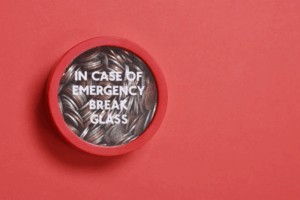A 90 day plan to build up an emergency fund from scratch
Life is unpredictable. From an unexpected medical bill, unemployment, or car repairs, an emergency fund will keep you safe from financial heartache. Saving an emergency fund seems like an unachievable goal for many, especially when money is tight. Yet, if you have a good plan, and a good attitude, you will soon develop a nice nest egg, in as little as 90 days.

This guide will show you exactly how to build an emergency fund in three months even on a tight budget. If you follow the above, and stay consistent with it, you will find yourself in a position to save sooner than you think.
The Importance of Having an Emergency Fund
Emergency Fund is money for unforeseen expenditure. That is not for holidays, shopping or bills you know you have to pay. You tuck this away for the inevitable moment that life hits you in the face with a brick — whatever that brick is for you.
Saving up three to six months’ worth in live savings minimum to some financial experts. However, even if you have between $1,000 to $2,500, it can help you get out of a bad situation. It’s better to start small than not to start at all.
Know How Much to Save: Step 1
The first step to saving in this way is to know how much you would like at the end of 90 days. Your goal has to be challenging, but not impossible to achieve. For example:
For example: if you save $10 per day, you will have $900 in 90 days.
If you save up to $15 every day, you will have $1,350 in 90 days.
For example, even if we only manage to save $5 each day, we will still have $450 after 3 months, which is already a good sign.
Keep a record of your ultimate goal and how you progress towards it each week. A clear target gives you a reason to keep moving.
Step 2 — Set up a separate savings account
It is easier not to spend more than a money when it is away from your regular account spending. You should open a separate savings account, ideally high-yield, to let your money accumulate interest while you save.
Find an account without fees and make it easy to transfer money. Hiding your emergency fund makes it less tempting to use.
Step 3: Record Every Single Penny Out The Door
Over the next 90 days, write down every single thing that you spend money on. You can utilize a budgeting app, use a spreadsheet, or even a notebook. Once you see it all on paper, you will find places where you can trim some fat.
For instance, if some would be shocked to learn how much money they spend on small items like coffee, snacks, or unused subscriptions. The first step in using that money for your savings is identifying the expenses.
Step 4: Cut Non-Essential Expenses
Cut unnecessary expenses to save for an emergency fund fast. How to save money fast: here are some options to consider:
Canceling unused subscriptions or memberships.
Making your own food rather than dining out.
Chose cheaper brands while buying groceries or household articles.
Hitting pause on entertainment expenses
Remember, these cuts are temporary. After getting your emergency fund, you can always incorporate these expenses back in.
Step 5: Explore methods to boost your earning potential
If your budget is already stretched thin, consider finding additional sources of income. So even by just using small amounts, they can accumulate. Some ideas include:
Selling unused items online.
Getting A Side Hustle (Freelance Work, Food Delivery, Tutoring, Etc.)
Providing baby-sitting, dog-walking, or yard work services.
Putting in additional hours at your current job when possible.
All the extra money you make should all go into your emergency fund.
Step 6: Automate Your Savings
Keep in your mind — consistency means the success to resolve the problem in a quick manner. When you get paid, have money transferred automatically from your checking to your savings. Think of it as a bill with top priority to pay.
Whenever you do get some unanticipated money, be it a tax refund, bonus, or gift, deposit that money right into your emergency fund. These bigger amounts can assist you to your goal quicker.
Step 7: Save in 90-Day Increments
This is an example of how you can save money in 90 days on a few different budgets:
| Daily Savings | Total After 30 Days | Total After 60 Days | Total After 90 Days |
|---|---|---|---|
| $5 | $150 | $300 | $450 |
| $10 | $300 | $600 | $900 |
| $15 | $450 | $900 | $1,350 |
| $20 | $600 | $1,200 | $1,800 |
Set the number that feels good to you and then do it for 3 months. Every penny counts and even saving a small amount every day is a great way to accumulate a significant amount of money
Final Step Number 8: Dont Touch the Fund Except in Cases of Emergency
The emergency fund you build — do not use that for anything except for emergencies (urgent needs). Losing your job, a surprise medical expense or needing emergency vehicle repairs are genuine emergencies.
If you used up any of your fund, replenish it at the soonest possible tim
Step 9: Continue with this approach after 90 Days
Save yourself by making saving a habit within 90 days. Then, continue increasing it until you hit a more comfortable figure, somewhere between three and six months of expenses. Now that your emergency fund is built, you can work on other financial goals such as retiring or paying off your debt or investing.
Final Thoughts
With a little bit of focus and dedication, you can build an emergency fund in just 90 days. Set a specific target, reduce unnecessary expenses, look for opportunities to make extra money and save with rigour to build up a buffer for a rainy day.
As they say, starting is the toughest thing to do. Even if you just manage to save a few bucks each and every day, you are making progress. Every small contribution adds up. Keep at it and within three months — BAM — your finances will be in a much better position.
Our Post

High Interest Rates, Credit Cards and the U.S. Consumer: What to Know in 2025
The Note: How Decelerating U.S. Economic Growth Affects Using Consumer Credit


